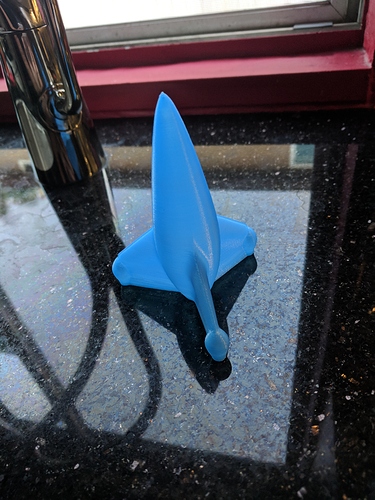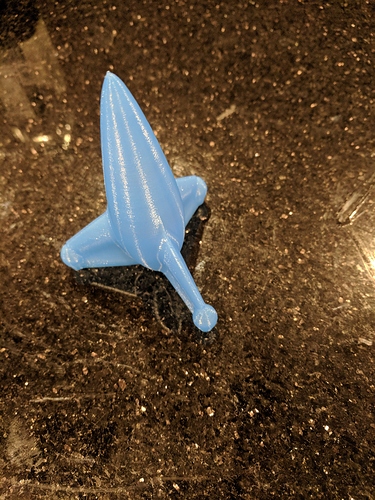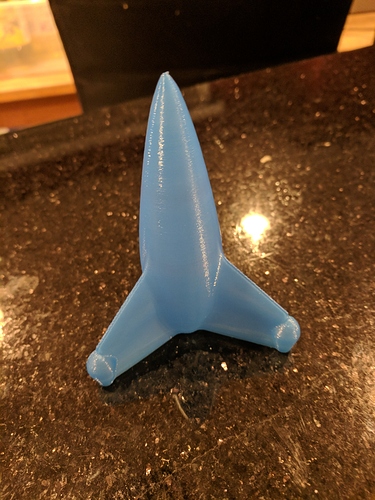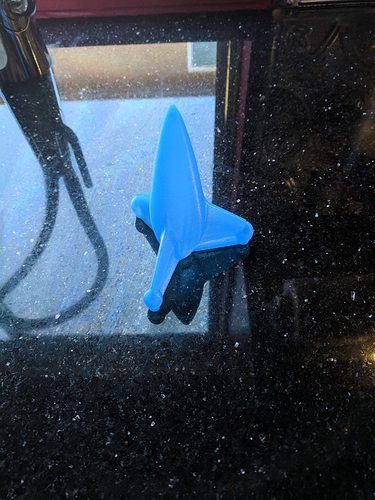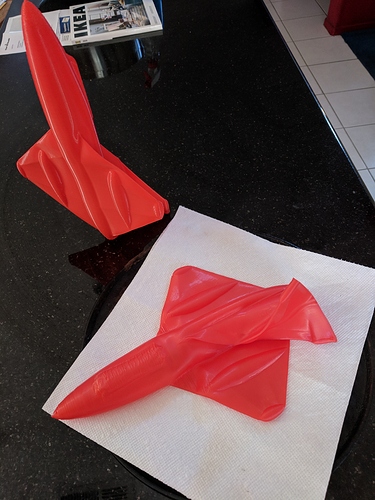Experiments with annealing PLA. Not a new subject, but going at this a bit differently. Started on accident - left a print in the trunk of my car, parked in full sun in Summer, in southern California, and - of course - it was after a bit warped.
Baked another of the same print in a 180F (convection) oven, to sad effect. (The orange rocket fighter-like things.)
To go at this more methodically, popped a delicate single/thin walled print into the oven for an hour at 140F. No apparent change. Another hour at 150, no change. Hour at 160 … and visible change (more opaque?), but no obvious change in shape. Hour each at 170, 180, 190, 200, 210, 220, 230, 240, 250, 260F with no apparent change.
At 270F, the first sign of failure - a small shiny spot near the nose, that grew slightly a 280 and 290F.
Starting to look like we can make temperature-resistant more delicate prints. Would want to repeat this exercise, to take less time.
Pictures are most recent, first.
You should also print things that you want annealed solid. Any Air trapped inside will cause problems. We paint things a lot and of course we want to speed up process with heat to cure fillers/paint more quickly so heat will make air pockets inside expand and that will show up nasty in your print. We only use abs so we are not annealing but nevertheless it’s basically the same for any material that gets exposed to excessive heat
@Matej_Rozman True, expanding air could be a problem, if you paint your parts, or otherwise seal the surface, and then want to heat the part. (Though you could get around this by leaving one surface unfinished, to allow air to escape.)
However, I print mostly functional objects. (Did paint one print, but only as an experiment.) Printing solid does not make sense in my case, as it would take a lot longer, and waste plastic.
Between each hour at temp, did you cool down the model to room temp?
If so, I wonder if it’s the thermal cycling that’s having the positive effect, not simply the upper temperature.
@Jason_McMullan Yes. This is a simple experiment. I set the oven for an hour at temperature and walk away. Usually by the time I come back to check, the print has cooled to near room temperature.
Also, the oven’s setting looks to be fairly accurate. A simple kitchen pocket thermometer, left in the oven always shows the set temperature when I wander past and check.
BTW, after an hour at 270F, the first signs of failure. Note the small shiny patch near the nose.
Boil it for 5 minutes. So easy less warping possibility.
@Jason_McMullan You wonder correctly. Each time you heat up a thermal plastic above the glass transition and cool it back down below that point you get what is called cross linking. Higher temperatures above the glass point generate more cross linking. Dwell time above that point also has an effect. 110-120F in an oven for 4-6 hours will do the much the same thing. Higher amounts of cross linking are related to higher melting points… within limits of course.
This is also why recycling printed plastic eventually runs you into issues as the recycled stuff will have a higher melting point than the fresh plastic it is mixed with. After 3 or 4 rounds of recycling you can have some parts of the filament that won’t melt at the same temperature as the rest and end up clogging the print head really bad.
@Preston_Bannister Thank you for posting the results of your experiments. +1
The relationship between temperature and dwell time for annealing plastics is a fascinating area of study to me.
